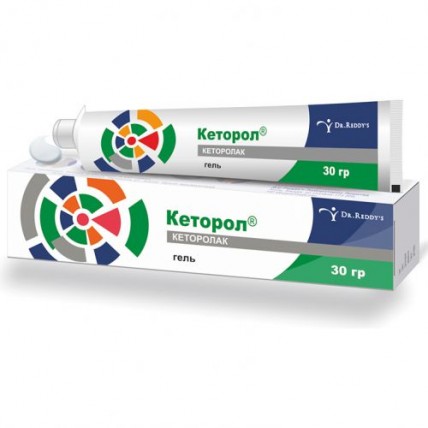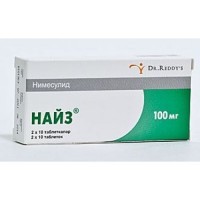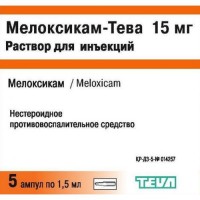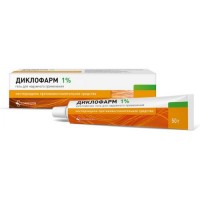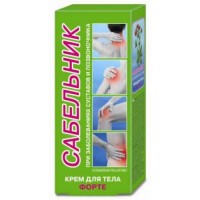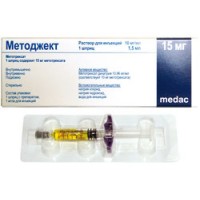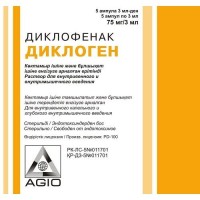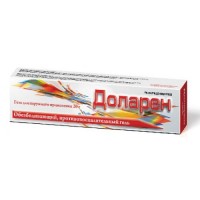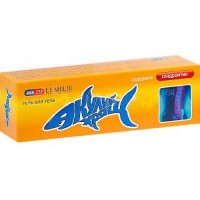The instruction for medical use
of Ketorol® medicine
the Trade name
of Ketorol®
the International unlicensed
name Ketorolak Lekarstvennaya a form
Gel
Structure
of 1 g of gel contains
active agent - a ketorolak trometamin 20.00 mg
excipients: propylene glycol, a dimethyl sulfoxide, carbomer 974 P (karbopol 974 P), sodium methylhydroxybenzoate, sodium propilgidroksibenzoat, trometamin, the water purified dgeatan Indian, ethanol, glitserol.
The description
Uniform, transparent or almost transparent gel with a characteristic smell.
Pharmacotherapeutic group
Drugs for treatment of diseases of a musculoskeletal system. Anti-inflammatory and antirheumatic drugs. Non-steroidal anti-inflammatory drugs. Derivatives of acetic acid.
ATX M01AB15 code.
The pharmacological
Pharmacokinetics Biological Value properties of a ketorolak are made by about 80-100%. The pharmacokinetics of a ketorolak is linear over usual initial range dosed Concentration of medicine in blood plasma in a quiet state about 50% higher, than after introduction of a single dose. As for other non-steroidal anti-inflammatory drugs, Ketorolak almost completely contacts proteins of plasma (& gt, 99%) that leads to the small visible volume of distribution (Vd)
. It is intensively metabolized, first of all, by merge to glucuronic acid and is allocated through kidneys. Metabolites have considerable anesthetic no effect. Average final elimination half-life (t ½ β) Ketorolaka at healthy volunteers made about 5 hours.
A pharmacodynamics
of Ketorol® – the non-steroidal anti-inflammatory drug (NPVS) possessing soothing and anti-inflammatory action. The main mechanism of action of a ketorol, as well as at other NPVS, is shown in its pharmacological effect - inhibition of synthesis of prostaglandins. Non-steroidal anti-inflammatory drugs (NPVS) are most active on the periphery.
Ketorol has no sedative or anxiolytic effect, does not influence opioid receptors. Ketorol does not possess the oppressing action on a respiratory center and does not strengthen the respiratory depression and sedation caused by opioid analgetika. Ketorol does not cause medicinal dependence. After sharp drug withdrawal the symptoms of cancellation do not arise.
Indications
- stopping of pains in muscles and joints
- a posttraumatic pain syndrome
- in bruises of soft tissues, such as sprain, bursitis, tendinitis, epicondylitis, synovitis, osteoarthritis of superficial joints.
A route of administration and doses
For external use.
A small amount of gel (3-5th) is applied a thin layer to skin of the inflamed or painful part of the body by 1-2 times a day rubbing finger-tips the easy massing movements. The dosage has to be picked up according to the area of an affected area.
To carefully wash out and dry up the struck areas before putting Ketorol gel. Drug is accurately applied to skin by massage movements, being distributed on area of the struck place, it should not be applied in the field of close to eyes, on mucous membranes or open wounds. Use of a hermetic bandage is not recommended to patients. Hands should be washed before use of this drug.
Side effects
Often (more than 3%)
- a headache, dizziness, drowsiness
- edemas of face, shins, anklebones, fingers, a foot
- increase in body weight
- nausea, dyspepsia, diarrhea,
Is less frequent (1 – 3%)
- skin rash, a purpura
- the increased perspiration
- a constipation, a meteorism, feeling of overflow of a stomach, vomiting, stomatitis
- increase in arterial blood pressure, heartbeat, pallor, a syncope, anemia, an eosinophilia
- an itching, rash
Seldom (less than 1%)
- gastritis, an eructation, anorexia, increase in appetite, dryness in a mouth
- an asthenia, a tremor, unusual dreams, an insomnia, hallucinations, euphoria, extrapyramidal symptoms, vertigo, paresthesia, a depression, nervousness, disturbance of thinking, inability to concentration of attention, hyperkinesias, a stupor, excessive thirst, disturbance of taste
- an acute renal failure, a back pain with or without hamaturia and/or azotemias, a hemolytic uraemic syndrome (hemolytic anemia, a renal failure, thrombocytopenia, a purpura), frequent urination, increase or decrease in volume of urine, nephrite, swell renal genesis, a hamaturia, a proteinuria, an oliguria, a hyponatremia, a hyperpotassemia, nephrite, swell renal genesis
- decrease in hearing, a ring in ears, a disorder of vision (including illegibility of visual perception)
- a bronchospasm or dispnoe, rhinitis, edema of laryngeal and lungs, cough
- anemia, an eosinophilia, a leukopenia
- bleeding from a postoperative wound, nasal bleeding, rectal bleeding
- fever, an infection
- an anaphylaxis or anaphylactoid reactions (discoloration of face skin, skin rash, a small tortoiseshell, an itching of skin, a tachypnea, swell a century, periorbital swelled, an asthma, the complicated breath, weight in a thorax, goose breathing)
- aseptic meningitis (fever, a severe headache, spasms, muscle tension of a neck and/or back), hallucinations, a depression, psychosis
- exfoliative dermatitis (fever with a fever or without it, reddening, consolidation or peeling of skin, swelling and/or morbidity of palatine tonsils), a small tortoiseshell, Stephens-Johnson's syndrome, a Lyell's disease
- a paraglossa, an angioedema.
Contraindications
- hypersensitivity to active agent and other components, acetylsalicylic acid or to other NPVS
- ulcer of stomach and duodenum, gastrointestinal bleedings or perforations of the ulcer of a stomach
- nose polyposes, the bronchospasm and a Quincke's edema which arose in the result of treatment with aspirin
- round ulcers
- hypocoagulation, including hemophilia
- hepatic and renal insufficiency
- a hemorrhagic stroke
- bleedings, including after operation
- hemopoiesis disturbance
- chronic pains
- pregnancy and the period of a lactation
- use in eyes, mucous membranes and open wounds
- an aspirinovy triad
- a hypovolemia
- dehydration
- children's and teenage age up to 18 years.
Medicinal interactions
the lack of cases of clinically considerable medicinal interactions at topical administration of Ketorol Is noted.
The following cases are accidental interactions at oral treatment of Ketorol as a result of which small reduction of ability of protein of blood plasma to connect warfarin is observed. Laboratory researches show that at therapeutic concentration of salt of salicylic acid the ability to connect Ketorol decreases approximately from 99.2% to 97.5%, representing a possibility of double increase in the Ketorola levels, untied blood plasma. It is reported that Ketorol's action reduces diuretic reaction to furosemide at normovolemichesky patients approximately by 20%. The accompanying Ketorol's use and a probenitsida leads to the reduced extent of clarification from Ketorol and to significant increase in keeping of Ketorol in blood plasma (approximately three times), approximately double increase in final elimination half-life is also observed. It was reported about increase in concentration of lithium in blood plasma as a result of suppression of a possibility of clarification of kidneys from lithium at intake of some non-steroidal anti-inflammatory drugs. Also reports on the increased lithium content were provided in blood plasma at Ketorolak's use. It was reported about the possible interaction of Ketorol and the kurarepodobny not depolarizing means leading to an apnoea. Accompanying Ketorol's use and APF inhibitors can increase risk of developing of a renal failure especially at patients with the exhausted organism. It was reported about several cases of epileptic seizures at the accompanying Ketorol's use and antiepileptic drugs (Phenytoinum, carbamazepine). Cases of hallucinations at the accompanying Ketorol's use with psychotropic drugs were observed (fluoxetine, thiotexin, to alprazola).
At laboratory testing
Ketorol suppresses aggregation of thrombocytes and can prolong a bleeding time.
Ketorolak trometamin 2% gel nursing mothers are not recommended to appoint the special instructions Pregnancy and the period of a lactation. Ketorolak discharge trometamin in breast milk after its systematic use is limited. As a result of a research with participation of 10 women it was revealed that the ratio of milk and plasma in concentration of a ketorolak trometamin varies from 0.015 to 0.037.
Use in pediatrics
the Recommended doses and indications by children Ketorolak of gel are not established yet.
As NPVS reduce aggregation of thrombocytes, it is necessary to appoint Ketorol with care sick with disturbance of a coagulant system of blood.
Use for patients from the liver broken by function
At Ketorol's reception is possible increase in level of hepatic transaminases therefore it is necessary to appoint a short course of treatment the patient with liver diseases.
Use for patients with impaired renal function
of Ketorol® is appointed by the patient with impaired renal function with care under control of analyses of urine.
Use for patients of advanced age
At Ketorol's reception the side reactions at patients of advanced age meet more often, purpose of low doses of drug is necessary. The maximum doses should not exceed 60 mg and it is necessary to accept with an interval of 6 - 8 hours.
Features of influence of medicine on ability to run the vehicle or potentially dangerous mechanisms
As at patients at Ketorol's appointment develop by-effects from the central nervous system (dizziness, drowsiness) and from sense bodys (decrease in hearing, a ring in ears, a disorder of vision), it is recommended to avoid performance of work, the requiring special attention and fast reaction.
Overdose
Symptoms: abdominal pains, nausea, vomiting, round ulcer of a stomach and duodenum, erosive gastritis, renal failure, metabolic atsidozirovanny
Treatment: gastric lavage, administration of adsorbents (the coal activated), symptomatic treatment.
The form of release and packing
On 30 g of gel place in the laminated aluminum tubas.
Each tuba together with the instruction for medical use in the state and Russian languages is put in a pack from cardboard
by
Storage conditions
to Store at a temperature not above 25 °C.
To store in the places inaccessible for children!
2 years
not to apply a period of storage after the expiry date specified on packing.
Prescription status
Without prescription
the Name and the country
of the organization - "Dr. of Reddi's Laboratoris Limited" producer
Hol, Buddy, St. Solana-173,205, NR India
the Name and the country of the owner of the registration certificate
Dr. of Reddi's Laboratoris Limited, India
the Address of the organization accepting in the territory of the Republic of Kazakhstan claims from consumers on quality of products
Representative office "Dr. of Reddi's Laboratoris Limited" in the Republic of Kazakhstan: 050057 Almaty, 22nd Line St., 45
ph. 8 (727) 3941688, fax: 8 (727) 3941294
To develop
of Ketorol® medicine
the Trade name
of Ketorol®
the International unlicensed
name Ketorolak Lekarstvennaya a form
Gel
Structure
of 1 g of gel contains
active agent - a ketorolak trometamin 20.00 mg
excipients: propylene glycol, a dimethyl sulfoxide, carbomer 974 P (karbopol 974 P), sodium methylhydroxybenzoate, sodium propilgidroksibenzoat, trometamin, the water purified dgeatan Indian, ethanol, glitserol.
The description
Uniform, transparent or almost transparent gel with a characteristic smell.
Pharmacotherapeutic group
Drugs for treatment of diseases of a musculoskeletal system. Anti-inflammatory and antirheumatic drugs. Non-steroidal anti-inflammatory drugs. Derivatives of acetic acid.
ATX M01AB15 code.
The pharmacological
Pharmacokinetics Biological Value properties of a ketorolak are made by about 80-100%. The pharmacokinetics of a ketorolak is linear over usual initial range dosed Concentration of medicine in blood plasma in a quiet state about 50% higher, than after introduction of a single dose. As for other non-steroidal anti-inflammatory drugs, Ketorolak almost completely contacts proteins of plasma (& gt, 99%) that leads to the small visible volume of distribution (Vd)
. It is intensively metabolized, first of all, by merge to glucuronic acid and is allocated through kidneys. Metabolites have considerable anesthetic no effect. Average final elimination half-life (t ½ β) Ketorolaka at healthy volunteers made about 5 hours.
A pharmacodynamics
of Ketorol® – the non-steroidal anti-inflammatory drug (NPVS) possessing soothing and anti-inflammatory action. The main mechanism of action of a ketorol, as well as at other NPVS, is shown in its pharmacological effect - inhibition of synthesis of prostaglandins. Non-steroidal anti-inflammatory drugs (NPVS) are most active on the periphery.
Ketorol has no sedative or anxiolytic effect, does not influence opioid receptors. Ketorol does not possess the oppressing action on a respiratory center and does not strengthen the respiratory depression and sedation caused by opioid analgetika. Ketorol does not cause medicinal dependence. After sharp drug withdrawal the symptoms of cancellation do not arise.
Indications
- stopping of pains in muscles and joints
- a posttraumatic pain syndrome
- in bruises of soft tissues, such as sprain, bursitis, tendinitis, epicondylitis, synovitis, osteoarthritis of superficial joints.
A route of administration and doses
For external use.
A small amount of gel (3-5th) is applied a thin layer to skin of the inflamed or painful part of the body by 1-2 times a day rubbing finger-tips the easy massing movements. The dosage has to be picked up according to the area of an affected area.
To carefully wash out and dry up the struck areas before putting Ketorol gel. Drug is accurately applied to skin by massage movements, being distributed on area of the struck place, it should not be applied in the field of close to eyes, on mucous membranes or open wounds. Use of a hermetic bandage is not recommended to patients. Hands should be washed before use of this drug.
Side effects
Often (more than 3%)
- a headache, dizziness, drowsiness
- edemas of face, shins, anklebones, fingers, a foot
- increase in body weight
- nausea, dyspepsia, diarrhea,
Is less frequent (1 – 3%)
- skin rash, a purpura
- the increased perspiration
- a constipation, a meteorism, feeling of overflow of a stomach, vomiting, stomatitis
- increase in arterial blood pressure, heartbeat, pallor, a syncope, anemia, an eosinophilia
- an itching, rash
Seldom (less than 1%)
- gastritis, an eructation, anorexia, increase in appetite, dryness in a mouth
- an asthenia, a tremor, unusual dreams, an insomnia, hallucinations, euphoria, extrapyramidal symptoms, vertigo, paresthesia, a depression, nervousness, disturbance of thinking, inability to concentration of attention, hyperkinesias, a stupor, excessive thirst, disturbance of taste
- an acute renal failure, a back pain with or without hamaturia and/or azotemias, a hemolytic uraemic syndrome (hemolytic anemia, a renal failure, thrombocytopenia, a purpura), frequent urination, increase or decrease in volume of urine, nephrite, swell renal genesis, a hamaturia, a proteinuria, an oliguria, a hyponatremia, a hyperpotassemia, nephrite, swell renal genesis
- decrease in hearing, a ring in ears, a disorder of vision (including illegibility of visual perception)
- a bronchospasm or dispnoe, rhinitis, edema of laryngeal and lungs, cough
- anemia, an eosinophilia, a leukopenia
- bleeding from a postoperative wound, nasal bleeding, rectal bleeding
- fever, an infection
- an anaphylaxis or anaphylactoid reactions (discoloration of face skin, skin rash, a small tortoiseshell, an itching of skin, a tachypnea, swell a century, periorbital swelled, an asthma, the complicated breath, weight in a thorax, goose breathing)
- aseptic meningitis (fever, a severe headache, spasms, muscle tension of a neck and/or back), hallucinations, a depression, psychosis
- exfoliative dermatitis (fever with a fever or without it, reddening, consolidation or peeling of skin, swelling and/or morbidity of palatine tonsils), a small tortoiseshell, Stephens-Johnson's syndrome, a Lyell's disease
- a paraglossa, an angioedema.
Contraindications
- hypersensitivity to active agent and other components, acetylsalicylic acid or to other NPVS
- ulcer of stomach and duodenum, gastrointestinal bleedings or perforations of the ulcer of a stomach
- nose polyposes, the bronchospasm and a Quincke's edema which arose in the result of treatment with aspirin
- round ulcers
- hypocoagulation, including hemophilia
- hepatic and renal insufficiency
- a hemorrhagic stroke
- bleedings, including after operation
- hemopoiesis disturbance
- chronic pains
- pregnancy and the period of a lactation
- use in eyes, mucous membranes and open wounds
- an aspirinovy triad
- a hypovolemia
- dehydration
- children's and teenage age up to 18 years.
Medicinal interactions
the lack of cases of clinically considerable medicinal interactions at topical administration of Ketorol Is noted.
The following cases are accidental interactions at oral treatment of Ketorol as a result of which small reduction of ability of protein of blood plasma to connect warfarin is observed. Laboratory researches show that at therapeutic concentration of salt of salicylic acid the ability to connect Ketorol decreases approximately from 99.2% to 97.5%, representing a possibility of double increase in the Ketorola levels, untied blood plasma. It is reported that Ketorol's action reduces diuretic reaction to furosemide at normovolemichesky patients approximately by 20%. The accompanying Ketorol's use and a probenitsida leads to the reduced extent of clarification from Ketorol and to significant increase in keeping of Ketorol in blood plasma (approximately three times), approximately double increase in final elimination half-life is also observed. It was reported about increase in concentration of lithium in blood plasma as a result of suppression of a possibility of clarification of kidneys from lithium at intake of some non-steroidal anti-inflammatory drugs. Also reports on the increased lithium content were provided in blood plasma at Ketorolak's use. It was reported about the possible interaction of Ketorol and the kurarepodobny not depolarizing means leading to an apnoea. Accompanying Ketorol's use and APF inhibitors can increase risk of developing of a renal failure especially at patients with the exhausted organism. It was reported about several cases of epileptic seizures at the accompanying Ketorol's use and antiepileptic drugs (Phenytoinum, carbamazepine). Cases of hallucinations at the accompanying Ketorol's use with psychotropic drugs were observed (fluoxetine, thiotexin, to alprazola).
At laboratory testing
Ketorol suppresses aggregation of thrombocytes and can prolong a bleeding time.
Ketorolak trometamin 2% gel nursing mothers are not recommended to appoint the special instructions Pregnancy and the period of a lactation. Ketorolak discharge trometamin in breast milk after its systematic use is limited. As a result of a research with participation of 10 women it was revealed that the ratio of milk and plasma in concentration of a ketorolak trometamin varies from 0.015 to 0.037.
Use in pediatrics
the Recommended doses and indications by children Ketorolak of gel are not established yet.
As NPVS reduce aggregation of thrombocytes, it is necessary to appoint Ketorol with care sick with disturbance of a coagulant system of blood.
Use for patients from the liver broken by function
At Ketorol's reception is possible increase in level of hepatic transaminases therefore it is necessary to appoint a short course of treatment the patient with liver diseases.
Use for patients with impaired renal function
of Ketorol® is appointed by the patient with impaired renal function with care under control of analyses of urine.
Use for patients of advanced age
At Ketorol's reception the side reactions at patients of advanced age meet more often, purpose of low doses of drug is necessary. The maximum doses should not exceed 60 mg and it is necessary to accept with an interval of 6 - 8 hours.
Features of influence of medicine on ability to run the vehicle or potentially dangerous mechanisms
As at patients at Ketorol's appointment develop by-effects from the central nervous system (dizziness, drowsiness) and from sense bodys (decrease in hearing, a ring in ears, a disorder of vision), it is recommended to avoid performance of work, the requiring special attention and fast reaction.
Overdose
Symptoms: abdominal pains, nausea, vomiting, round ulcer of a stomach and duodenum, erosive gastritis, renal failure, metabolic atsidozirovanny
Treatment: gastric lavage, administration of adsorbents (the coal activated), symptomatic treatment.
The form of release and packing
On 30 g of gel place in the laminated aluminum tubas.
Each tuba together with the instruction for medical use in the state and Russian languages is put in a pack from cardboard
by
Storage conditions
to Store at a temperature not above 25 °C.
To store in the places inaccessible for children!
2 years
not to apply a period of storage after the expiry date specified on packing.
Prescription status
Without prescription
the Name and the country
of the organization - "Dr. of Reddi's Laboratoris Limited" producer
Hol, Buddy, St. Solana-173,205, NR India
the Name and the country of the owner of the registration certificate
Dr. of Reddi's Laboratoris Limited, India
the Address of the organization accepting in the territory of the Republic of Kazakhstan claims from consumers on quality of products
Representative office "Dr. of Reddi's Laboratoris Limited" in the Republic of Kazakhstan: 050057 Almaty, 22nd Line St., 45
ph. 8 (727) 3941688, fax: 8 (727) 3941294
To develop
